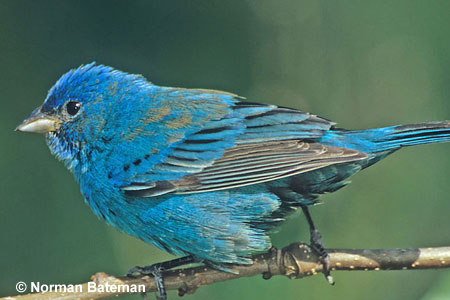Indigo Buntings (Passerina cyanea) look like pieces of sky fluttering around. Well, at least the males in their breeding plumage do, females are much more modest.
You can find them along brushy and weedy roadsides, forest edges, and farmlands, often singing atop high perches or foraging amongst concealing vegetation. If you want to spot and identify them, here’s all you need to know!
On this page
Identification
Indigo Buntings are finch-like, sparrow-sized birds with a stocky build, short tail, and conical bill. They measure around 4.5-5.9 inches long and have a wingspan of 7.1-9.1 inches. When they’re flying, you can recognize them by their plump bodies and rounded tails.
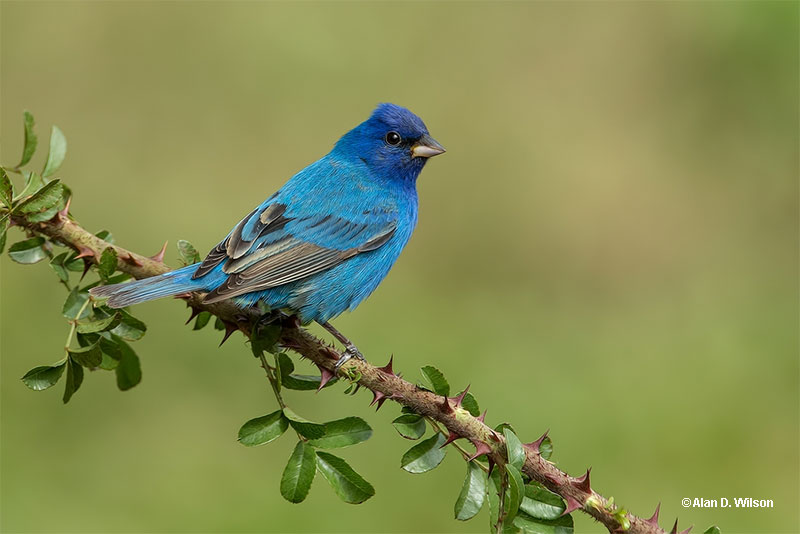
© Alan D. Wilson
Male Indigo Buntings look different depending on the season.
During the breeding season, they have vibrant cerulean blue plumage with black on their tails and wings. Only their heads have indigo hues.
In fall and winter plumage, however, the male looks more modest, appearing mostly brown with blue mottling.
Female Indigo Buntings are mostly brown with a pure white throat and a white underside that has faint cinnamon streaking. They only have a tinge of blue on their shoulders, wings, and tails, but this might not be visible.
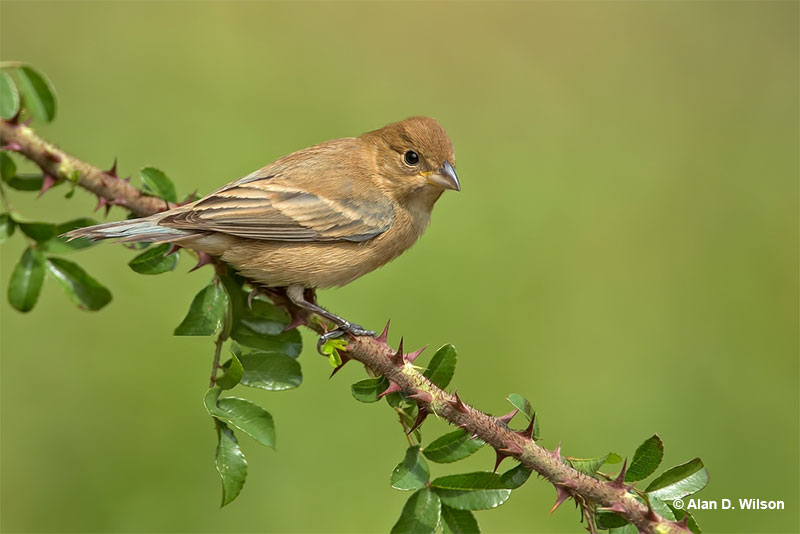
Juvenile Indigo Buntings look like females and immature males are a patchwork of brown and blue.
Indigo Buntings call with a sharp chip which is used as an alarm call. Only the male sings, and their songs are 2-4 seconds long sweet whistling warbles.
They repeat each note and phrase twice, and the phrases may sound like chew-chew sweet-sweet or what-what where see it see it. Look for them perching on elevated objects such as wires, top branches of bushes, and posts.
Food
Indigo Buntings’ diet consists of both animal and plant matter. During the breeding season, their primary diet consists of small spiders and insects, as well as seeds of grasses and berries like blueberries, strawberries, blackberries, serviceberries, and elderberries.
They are particularly fond of caterpillars, grasshoppers, aphids, cicadas, and beetles. Indigo Buntings do not seem to drink frequently, as they obtain sufficient water from their food.
They forage alone during the breeding season, feeding on insects from leaves and seeds from the ground or stems, while in winter, they form flocks and mainly rely on small seeds of grasses.
These birds are versatile foragers, exploring all levels from the ground up into shrubs and trees to find their meals.
In spring, they may also consume buds and leaves from various tree species upon their arrival at the breeding grounds.
Nesting and Eggs
During springtime, male Indigo Buntings establish their territories and defend them through song. The birds are generally monogamous, although males may switch partners after egg-laying is complete.
Courtship involves the male following his mate during nest building and egg-laying, often driving away other males.
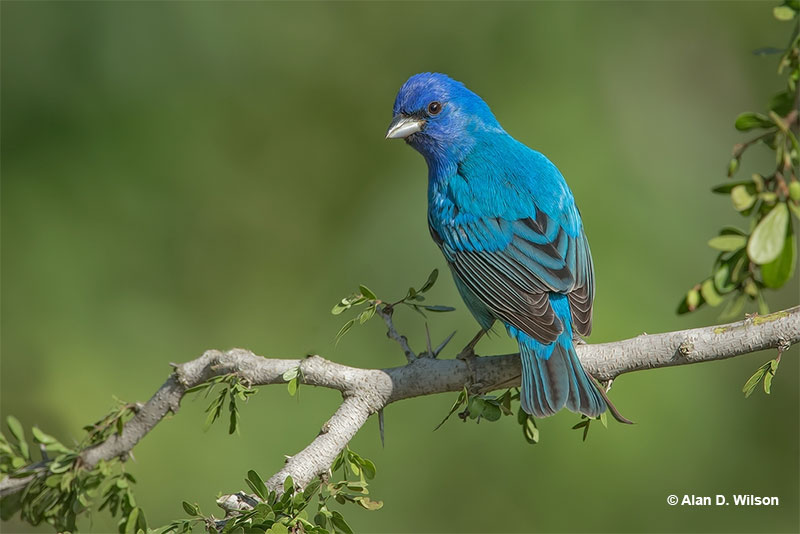
Indigo Buntings nest in concealed places on the edges of woods, roadsides, and fields. The female chooses the nest site, which is typically 1-3 feet above the ground in low vegetation or at the juncture of branches.
She then weaves an open cup from leaves, stems, grasses, and bark strips and lines it with finer material such as thistledown, fine grass, or hair. The finished nest is small, only 3 inches in diameter and about 1.5 inches deep.
These birds generally have two broods per season with 1-4, generally 3-4 eggs in a clutch.
Indigo Bunting eggs are about 0.8 inches long and 0.6 inches wide and although they are generally pure white to bluish-white, they can have brownish spots. The mother bird incubates them for 11-14 days and broods the chicks for a few days after hatching.
In most cases, the female is the only one taking care of the nestlings. Occasionally, though, the male may take over the feeding duties when the chicks are almost fledged, and the female wants to begin the second nesting attempt.
The younglings leave the nest 9-12 days after hatching and become independent about 3 weeks after that.
Current Situation
Indigo Buntings range throughout most of the United States and Central America. They mainly breed in eastern North America and migrate to Central North America and northernmost South America for the winter.
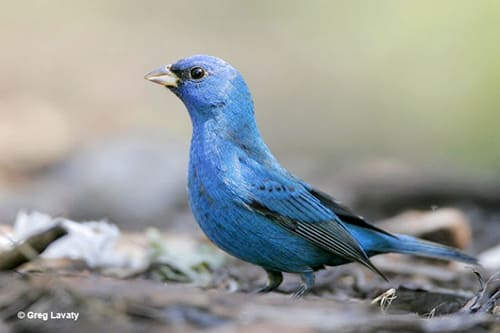
You can find Indigo Buntings in various brushy and overgrown habitats singing from prominent perches or foraging among shrubs and grasses.
During the breeding season, they are commonly found in brushy and weedy areas along the edges of farmlands, woods, roads, power lines, railways, and riparian zones. They also breed in clearings within open deciduous woodlands, weedy or abandoned agricultural fields, and swamps.
During migration, they seek open grasslands and leafy trees similar to their winter habitat. In winter, Indigo Buntings prefer open habitats, such as weedy fields, citrus orchards, savannas, weedy croplands, and areas with low second growth.
Indigo Buntings are listed as of least concern on the IUCN Red List. On the one hand, this species is negatively influenced by intensive agriculture, frequent mowing, reforestation, and urbanization. On the other hand, the expansion of weedy and shrubby habitats balances it out.
Facts
- Indigo Buntings migrate at night and use stars to do so. Their migration may be as lengthy as 1,200 miles!
- Indigo Buntings learn their songs from other males nearby. This is why Indigo Buntings in one area sing similar songs whereas Indigo Buntings in another area sing different ones. The songs of one certain “neighborhood” change over time as new males join.
- Although Indigo Buntings appear beautiful cerulean blue, then their plumage and feathers actually lack blue pigments. We see blue because the structure of the feathers reflects blue light.
- The ranges of Indigo Buntings and Lazuli Buntings overlap, and they are known to fight each other over territories. On the other hand, the two species are known to interbreed and mix songs.
- Indigo Buntings don’t usually visit bird feeders. If you want to attract them, you may offer thistle seeds, nyjer, or mealworms.
Similar Species
There are surprisingly many species rather similar to the Indigo Bunting. We have described four of them and how to tell them apart.
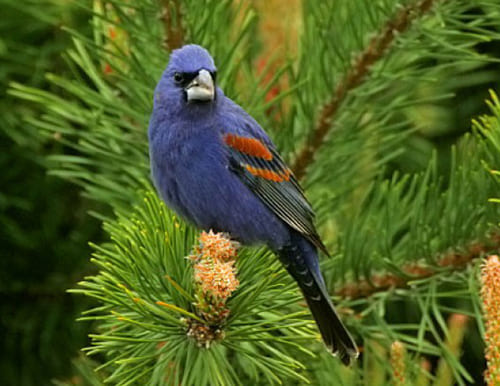
Blue Grosbeak
Blue Grosbeaks are larger and have thicker bills.
Males in their breeding plumage have rust-colored wingbars instead of black wingbars.
Females are overall very similar but female Blue Grosbeaks have a richer coloration and darker wingbars.
Read more: Blue Grosbeak vs Indigo Bunting – What are the differences?
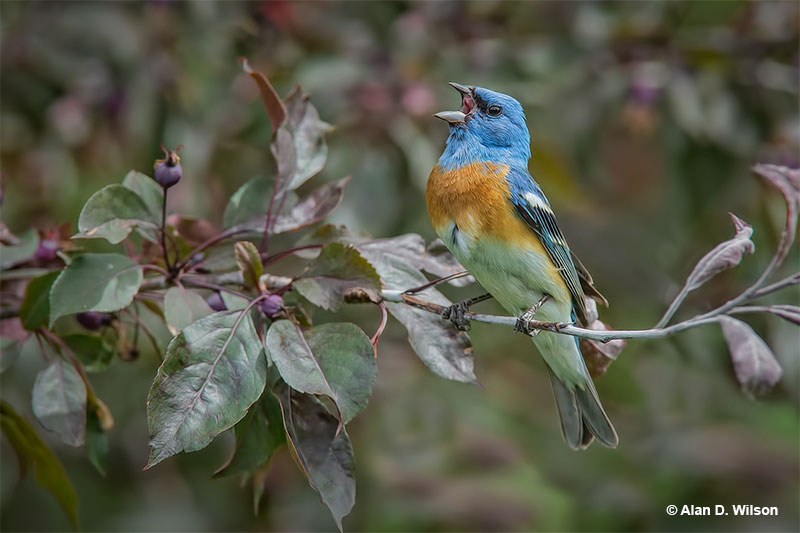
Lazuli Bunting © Alan D. Wilson
Breeding male Lazuli Buntings can be separated from the male Indigo Buntings thanks to the light rust-colored wash on their chest.
However, females look more similar. Female Lazuli Buntings don’t have a white throat and have warm cinnamon-colored breasts, whereas the female Indigo Bunting has a white throat and light streaking on the underside.
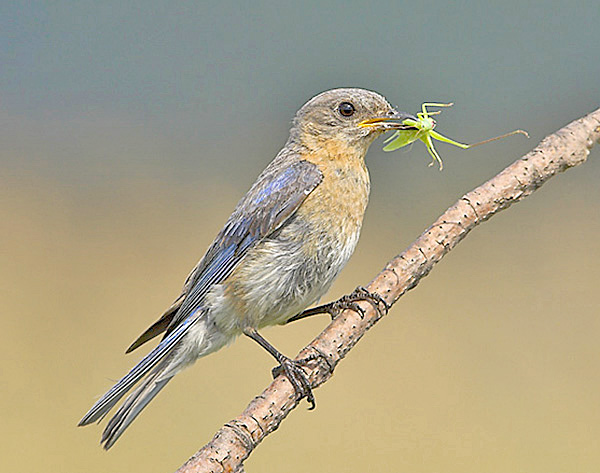
Female Eastern Bluebird. Photograph © Glenn Bartley.
Males of the two species are quite different, but female Eastern Bluebirds may be confused with female, immature, and nonbreeding male Indigo Buntings.
However, female Eastern Bluebirds are larger, have a rust-colored wash on their breasts and sides, and have a straight and thin black bill.
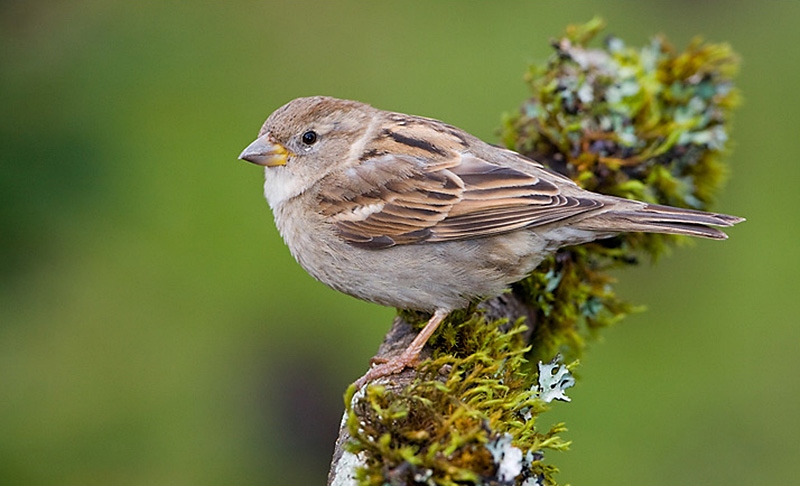
Female House Sparrow
Female House Sparrows and Indigo Buntings look rather similar.
However, female House Sparrows have a more contrasting plumage consisting of black, brown, buff, and off-white colors, whereas the female Indigo Bunting is more uniformly colored.
Frequently Asked Questions
What is the difference between an Indigo Bunting and a Blue Bunting?
Although relatively similar, the Blue Bunting lives only in Central America, whereas the Indigo Bunting breeds in North America and winters in Central America. They are two separate species.
Is an Indigo Bunting rare?
Indigo Buntings are abundant throughout their range but they are shy creatures that prefer to forage in brushy and concealed areas.
Where are Indigo Buntings most common?
Indigo Buntings are most common in brushy and weedy areas such as overgrown fields, wood edges, and roadsides.
Where do Indigo Buntings go in the winter?
Indigo Buntings migrate to Central and northernmost South America for the winter.
What does it mean if you see an Indigo Bunting?
Seeing an Indigo Bunting can mean different things based on what you believe in, such as change, hope, renewal, or spiritual realization.

